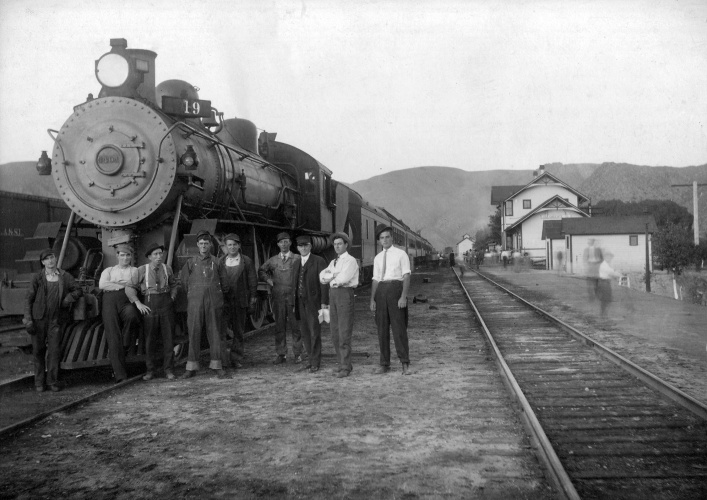Courting at the Train Depot

Roy C. Dearing in Caliente Train 19 (4th from left)
Two Dearing Brothers, George (eldest) and Roy Christopher Dearing (our grandfather) worked for the Railroad out of Milford, Utah. Milford was a dropping off point for ores that were freighted in from mines in Nevada, southern Utah and areas around Milford. Working for the railroad, Roy was enumerated twice in the 1910 Census - on April 18, 1910, he was found in Los Angeles, Calif., and on May 7, he was in Caliente, Nev.
Roy worked as a coal tender or a brakeman for the railroad, which ran between Milford, Utah, and Caliente, Nev. He also worked as a fireman for this railroad. He met our grandmother, Myrtle Hickman in Milford, at the local train station. We don't know how they first met, or who introduced them, but they came to know each other.

Close up of Train 19 (Roy Dearing second from left)
On the caboose, Roy would wave as the train rolled into town. Myrtle would stand on the landing of the depot waiting to wave back. He would drive as an engineer blowing the whistle through the town sometimes, and let everyone know he was coming. For miles and miles before reaching Milford, he would blow the horn notifying the townspeople. Paying particular attention, Myrtle would listen for that whistle. After knowing he was coming, she would go to the depot for lunch and eat down there.
From written histories, most of their courting was done at the train depot or around the station when he came to visit. When Roy got transferred to Salt Lake with his brother George, it was devastating to Myrtle. She went with her sister Vivian to meet him in Salt Lake, and while there, Roy announced he was going to marry Myrtle. For a while after their marriage, they lived in Milford while he continued to work for the railroad in various capacities.

Roy Christopher Dearing in Railroad attire, later in life.
Later during the Depression, they moved to Springville, Utah, with their 13 children. Roy worked at the Ironton Plant, which utilized trains for transporting ore to the steel plant. When the trains would drive by his home, they would slow down, and Roy would jump on the railroad coal car, and throw coal off the train along the track. His children would put it in gunny sacks and take it to their house for heating. When the railroad ties were traded out, he had them chopped up to be used for heat for their small home. During a hard time, this was one way he could provide comfort to his family.
He also appreciated the impact the railroad played on the American west, and he was part of the history. I am proud my grandfather had a small part to play in this saga, but more excited that trains played a
part in my grandparents' marriage.
(Lorinda Mann and Carin Green)
